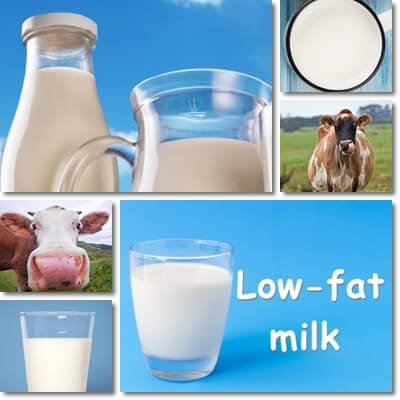By definition, low-fat milk is milk from which some of the fat content has been removed. It is also called reduced-fat because it has a reduced fat content compared to whole milk. The main purpose of removing some of the fat is to produce a healthier dairy product that appeals to a more health-conscious segment of the population as well as target consumers struggling with weight gain and associated health problems, including but not limited to type 2 diabetes, hyperlipidemia (high blood lipids) and hypercholesterolemia (high blood cholesterol levels).
Low-fat milk types are obtained by completely removing the butterfat in whole milk, then reintroducing part of it prior to offering it up for consumption. What percent is low-fat milk? The most common percentages include 2%, 1.8%, 1.5% and 1% (butter)fat for cow, sheep, goat and some buffalo milk. For the most part, anything below 3% butterfat fat and over 0.5% is considered low-fat. 3% and upwards (up to 6%) is whole milk, while 0.5% to 0.1% is non-fat or skim. An exception is water buffalo milk which naturally has around 8 g of fat per 100 ml. Low-fat versions of this milk are 3% fat, as much as whole cow milk, for example.

Regionally-available milk varieties
These also exist (example: camel, donkey, horse, yak, reindeer and even pig). Some of these may have low-fat options as well. However, fat content in regional milk varieties may differ significantly from the fat content of more traditional options. For example, donkey milk is typically 0.3 to 1.8% fat, which is already as low as low-fat and skim, traditional cow, sheep and goat. Horse is also usually low-fat. Moose milk on the other hand is around 10% fat, which is higher than any traditional options (including water buffalo which has 8 g of fat in every 100 ml). But because of its scarcity and the appreciation it enjoys as a result, it’s usually not made into low-fat options.
For the most part, low-fat options undergo three processes prior to being commercialized:
1) Micro-filtration to remove impurities.
2) Pasteurization: heating for bursts of around 15 seconds to destroy microorganisms that could cause spoilage and subsequent disease. Also prolongs shelf life.
UHT (ultra-heat treatment/ultra-high temperature/ultra-pasteurization): heating at much higher temperatures than regular pasteurization for the same purposes (requires 1-2 seconds). Both processed are followed by packaging in aseptic conditions.
3) Homogenization to create a uniform texture that greatly improves mouthfeel. It is a mechanical process that breaks down the fat globules in the milk which prevents the butterfat to separate from the liquid and rise at the surface and, at the same time, allows it to better disperse within the liquid, creating a uniform consistency.
4) Fortification (optional). Depending on the processes milk undergoes, loss of nutritional value occurs to various degrees. The more intense the pasteurization and the lower the fat content, the lower the nutrition. As such, fortification adds lost vitamins and sometimes also minerals to return the milk to its original nutritional value and even improve it. Read the label for information on the exact nutritional value of the product of your choice.

What does low-fat milk taste like?
Traditional cow, goat, sheep options (pasteurized and homogenized) have a delicately sweet taste and a light, smooth texture. Low-fat water buffalo has a slightly richer taste due to its 3% fat content. As for appearance, color is white with a uniform look. Both taste and appearance are influenced by any processing the product undergoes. Raw milk has better flavor and a richer, creamier texture, although it’s perceived as less sweet.
Raw low-fat milk is also available in some parts of the world, but it requires very careful handling (must be kept in refrigerator conditions from the moment it’s produced and up until consumption) as well as has a significantly shorter shelf life (on average, a few days to one week tops in refrigerator conditions). It’s also usually homogenized for a more uniform consistency.
Interesting facts about low-fat milk nutrition:
1) Because it has less fat, it also has less fat-soluble vitamins, especially vitamins A and E.
2) Less fat means a poorer absorption of fat-soluble vitamins (A, D, E and K) from other sources.
3) The lower the fat content, the higher the lactose content. So if you’re dealing with a mild form of lactose intolerance (and thus don’t rely on lactose-free milk), low-fat options such as 1% may upset you more than whole milk.
4) Pasteurization causes complete loss of vitamin C.
5) Ultra-pasteurization (UHT) further causes an often significant loss of B vitamins, especially vitamins B1, B2, B6, B9, B12 (unless fortified – but fortification often does not cover the whole range of lost nutrients).
6) It’s slightly less satiating and filling than whole milk which may prompt further eating and undermine the supposed weight loss benefits.
7) The lower fat content does not promote weight loss and does not lower cardiovascular disease risks.
First of all, low-fat milk is but one of many foods you eat in a day so its overall role in your daily calorie intake is rather insignificant (unless you have excessive amounts every single day). Secondly, there is no benefit for cardiovascular health that derives from the reduced saturated and overall fat content. Actually, eating unsaturated Omega-3 (alpha-linolenic acid) and Omega-6 (linoleic acid) fatty acids helps boost HDL (good) cholesterol levels, while helping lower LDL (bad) and total cholesterol. Saturated fats in milk such as stearic acid further help lower LDL cholesterol.
Eating fat is healthy and the body has mechanisms set in place to balance out occasional excesses without any adverse effects for the cardiovascular system or overall health. Just like when you get more cholesterol from food your body produces less to match your nutritional requirements. Most important, every single nutrient present naturally in milk serves important functions in the human body, from anti-inflammatory effects to anticancer properties to neuro-protective actions (and more).
But what are the health benefits of drinking low-fat milk (in moderation)? Here are some positive aspects to consider:
1) Pasteurization and ultra-pasteurization eliminate the risks for food-borne diseases caused by Escherichia coli, Listeria monocytogenes, Salmonella, Yersinia enterocolitica and other bacteria, molds and yeasts.
2) Pasteurization and ultra-pasteurization inactivate tuberculosis-causing bacteria (Mycobacterium tuberculosis).
3) UHT milk has a shelf life of 6-9 months at room temperature (if you don’t open the package).
4) Good amounts of protein provide satiety and contribute to sustained energy levels. There are, on average, 3.1 g of protein in goat milk, 3.2 g in cow, 4.5 g in water buffalo and 5.4 g in sheep. Existing fat also provides satiety.
5) Protein helps build and maintain muscle tissue.
6) The amino acids that make up the protein in milk, both essential and non-essential, help synthesize neurotransmitters in the brain that regulate mood, appetite, sleep and other processes.
7) Good amounts of vitamin A support eyesight – vision acuity, color vision and vision in dim light as well as offer a certain level of protection against age-related macular degeneration/loss of vision.
8) Vitamin A further benefits skin, in combination with all forms of fat, vitamin E and B vitamins.
9) There are benefits for brain and nervous system health from B vitamins, cholesterol and other fats. For example, vitamin B12 and cholesterol protect the myelin sheath, the coating surrounding the tail of nerve cells – which allows for an impeccable brain-body communication.
10) If present through fortification, vitamins B9 and B12 combat anemia and fatigue and have an energizing, revitalizing effect.
11) In pregnant women, vitamins B9 and B12 contribute to the normal development of the baby’s brain and nervous system.
12) Minor benefits for blood sugar control thanks to fat and protein which reduce the rate of sugar absorption into the bloodstream and contribute to a steadier rise in blood sugar levels.
13) Maintains good amounts of calcium and a modest phosphorus and magnesium content and thus helps strengthen bones and teeth. Vitamin D added through fortification optimizes calcium absorption.
14) Higher potassium content for better blood pressure numbers. How much potassium is in milk? On average, whole cow milk (3.25% fat) has 132 to 150 mg of potassium per 100 ml. Low-fat, 1% and 2% cow milk has 162 to 182 mg of potassium per 100 ml. Goat milk has even more of the blood pressure-regulating mineral than cow and potassium content is higher in the reduced-fat version.
Lastly, possible disadvantages and side effects of low-fat milk include:
1) Loss of essential vitamins through pasteurization: B1, B2, B6, B9, B12, C and E.
2) Loss of healthy fatty acids, including Omega-3 and Omega-6 (which hold anti-inflammatory properties and benefits for the cardiovascular system and brain function).
3) Partial loss of healthy saturated fats such as stearic acid which helps lower LDL cholesterol.
4) Denaturation of enzymes, proteins and some antioxidants resulting in a loss of nutritional properties and benefits derived from the actions of said enzymes, proteins and antioxidants.
5) Low-fat options have a higher lactose content which may cause more digestive upset in mildly lactose intolerant individuals that whole milk.
6) Allergy to milk proteins that can build up from digestive upset to breathing problems and ultimately cause anaphylactic shock. If you are allergic to milk, avoid consuming it in all forms and all products.
7) Pasteurization may remove pathogenic bacteria, molds and yeasts, but also removes beneficial microorganisms that enrich digestive flora and contribute to benefits such as better immunity, improved digestion, production of B vitamins and vitamin K at intestinal level etc.
